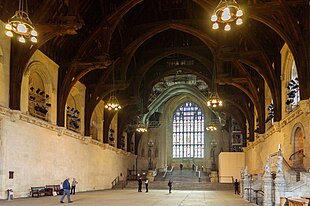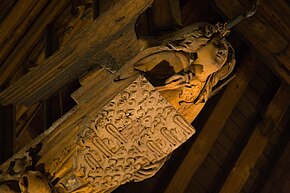Westminster Hall is a large medieval great hall which is part of the Palace of Westminster in London, England. It was erected in 1097 for William II ("William Rufus"), at which point it was the largest hall in Europe.[1] The building has had various functions over the years, including being used for judicial purposes from the twelfth to the nineteenth centuries. When a joint address is given to the two chambers of the UK Parliament, the House of Commons and House of Lords, the hall is typically the venue. It was also used to host coronation banquets until 1821, and since the twentieth century has been the usual venue for the lyings in state of state and ceremonial funerals.

The fabric of the hall is particularly notable for its hammerbeam roof, a form typical of English Gothic architecture which uses horizontal trusses to span large distances. The roof was commissioned for Richard II in 1393 and built by the royal carpenter, Hugh Herland.[2] It is the largest clearspan medieval roof in England, measuring 20.7 by 73.2 metres (68 by 240 ft).[3][4] At the same time the rest of the hall was remodelled by the master mason Henry Yevele.[5] The renovations include eighty-three unique depictions of Richard's favourite heraldic badge, a resting chained white hart.[6]
History
Westminster Hall has served numerous functions. Until the 19th century, it was regularly used for judicial purposes, housing three of the most important courts in the land: the Court of King's Bench, the Court of Common Pleas and the Court of Chancery. In the reign of Henry II (1154–89) a royal decree established a fixed sitting of judges in the Hall. In 1215, Magna Carta stipulated that these courts would sit regularly in the Hall for the convenience of litigants.[7] In 1875, the courts were amalgamated into the High Court of Justice, which continued to have chambers adjacent to Westminster Hall until moved to the then new Royal Courts of Justice building in 1882.[8][9] In addition to regular courts, Westminster Hall also housed important state trials, including impeachment trials and the state trials of King Charles I at the end of the English Civil War, William Wallace, Thomas More, Cardinal John Fisher, Guy Fawkes, the Earl of Strafford, the rebel Scottish lords of the 1715 and 1745 uprisings, and Warren Hastings. On the night of 10 May 1941 at the height of the Blitz, the Palace of Westminster was showered with incendiary bombs. Scottish politician Walter Elliot happened to be nearby, and directed firefighters to prioritise saving the medieval Hall rather than the Chamber of the House of Commons, whose roof was also alight, and smashed through a door to the Hall with an axe so hoses could be brought in.[10]
The St Stephen's Porch end of the Hall displays under the stained glass window the Parliamentary War Memorial listing on eight panels the names of Members and staff of both Houses of Parliament and their sons killed serving in the First World War; the window itself, installed in 1952, commemorates members and staff of both Houses who died in the Second World War. In 2012, a new stained glass window commemorating Queen Elizabeth II's diamond jubilee was installed opposite this window, at the other end of the hall.[11]

Westminster Hall has also served ceremonial functions. From the twelfth century to the nineteenth, coronation banquets honouring new monarchs were held here. The last coronation banquet was that of King George IV, held in 1821;[12] his successor, William IV, abandoned the idea because he deemed it too expensive. Since the late 19th century, the Hall has been used as a place for lying in state during state and ceremonial funerals. Such an honour is usually reserved for the Sovereign and for their consorts; the only non-royals to receive it in the twentieth century were Frederick Sleigh Roberts, 1st Earl Roberts (1914), the 48 victims of the crash of the airship R101 (1930)[13] and Winston Churchill (1965). In 1910 the hall was used for the lying in state of King Edward VII, followed by King George V in 1936, King George VI in 1952, Queen Mary in 1953, Queen Elizabeth The Queen Mother in 2002, and Queen Elizabeth II in 2022.[14][15] Around 250,000 mourners filed past the coffin when Queen Elizabeth II lay in state, which resulted in the delamination of the Yorkstone floor.[16]
The two Houses have presented ceremonial Addresses to the Crown in Westminster Hall on important public occasions. For example, Addresses were presented at Elizabeth II's Silver Jubilee (1977), Golden Jubilee (2002) and Diamond Jubilee (2012), the Accession of Charles III (2022), the 300th anniversary of the Glorious Revolution (1988), and the fiftieth anniversary of the end of the Second World War (1995).
It is considered a rare privilege for a foreign leader to be invited to address both Houses of Parliament in Westminster Hall. Since the Second World War, the only leaders to have done so have been French president Charles de Gaulle in 1960, South African president Nelson Mandela in 1996, Pope Benedict XVI in 2010, U.S. president Barack Obama in 2011, Burmese opposition leader Aung San Suu Kyi in 2012, and Ukrainian president Volodymyr Zelenskyy in 2023.[17][18][19][20] President Obama was the first US president to be invited to use the Hall for an address to Parliament[21] and Aung San Suu Kyi was the first non-head of state to be given the accolade of addressing MPs and peers in Westminster Hall.
Following reforms in 1999, the House of Commons now uses the Grand Committee Room next to Westminster Hall as an additional debating chamber. (Although it is not part of the main hall, these are usually spoken of as Westminster Hall debates.) In contrast with the two main Chambers, in which the government and opposition benches directly face each other, the seating in the Grand Committee Room is laid out in a U-shape, a pattern meant to reflect the non-partisan nature of the debates there.
Architecture

The hall is notable for its hammerbeam roof, which was commissioned for Richard II in 1393.[2] It was built by the royal carpenter, Hugh Herland, and is considered "the greatest creation of medieval timber architecture". creating a single huge open space, with a dais at the end. Richard's master builder Henry Yevele retained the original dimensions, refacing the walls, with fifteen life-size statues of kings placed in niches.[5] The rebuilding had been begun by King Henry III in 1245, but by Richard's time had been dormant for over a century. Included in Richard's renovations are repetitions of his favourite heraldic badge – a white hart, chained, and in an attitude of rest – which is repeated eighty-three times, without any of them being an exact copy of another.[6]
The largest clearspan medieval roof in England, Westminster Hall's roof measures 20.7 by 73.2 metres (68 by 240 ft).[3] Oak timbers for the roof came from royal woods in Hampshire and from parks in Hertfordshire and from that of William Crozier of Stoke d'Abernon, who supplied over 600 oaks in Surrey, among other sources; they were assembled near Farnham, Surrey, 56 kilometres (35 mi) away.[4] Accounts record the large number of wagons and barges which delivered the jointed timbers to Westminster for assembly.[22]
New Dawn
New Dawn is a glass artwork by Mary Branson, installed in Westminster Hall in 2016. It celebrates the campaign for women's suffrage, and is illuminated with light levels changing according to the tidal level of the River Thames.[23][24][25]